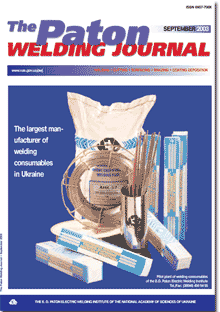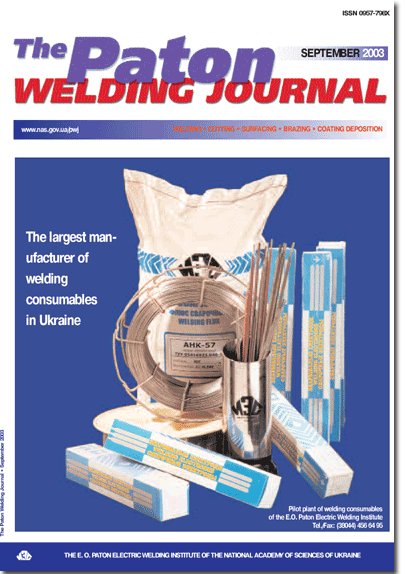

(You are viewing the simplified file contents)
AS = «Automatic Welding» - 6 issues per year;
TPWJ = «PATON WELDING JOURNAL» - 12 issues per year;
SEM = «Electrometallurgy Today» - 4 issues per year;
TDNK = «Technical Diagnostics and Non-Destructive Testing» - 4 issues per year.


| SCIENTIFIC AND TECHNICAL | |
| Kovalchuk V.S.
Allowance for effect of cycle asymmetry on cyclic crack resistance of materials and welded joints. | 2 |
| It was established from the results of investigations of high-strength steel welded joints that increase in values of the coefficient of asymmetry from 0 to 0.5 leads to the 3-4 times increase in rate of fatigue crack propagation at the initial region of a mean-amplitude area of kinetic diagrams of fatigue fracture and has almost no effect at its final region. Based on the analysis of these and literature data, the method and analytical expressions are suggested allowing the cycle asymmetry to be taken into account within wide ranges in determination of a cyclic crack resistance using a limited number of initial parameters. | |
| Nesterenkov V.M.
Application of a scanning electron beam for welding to prevent root defects in thick steels. | 5 |
| Influence was studied of disturbances of the liquid metal surface, which is on the front wall of the keyhole, on development of root defects in electron beam welding of thick steel. It is shown that a longitudinal scanning of the electron beam allows decreasing the disturbances of melt surface on the front wall of the keyhole and reducing the number of root defects in welds. | |
| Nazarchuk A.T., Snisar V.V. and Zaburanny Yu.A.
Assessment of technological strength of plate hardenable steel joints with multilayer welds. | 11 |
| Peculiarities in the development of a new approach to assessment of technological strength of hardenable steel joints with multilayer welds are considered. On their basis the feasibility of application of a method of composite specimens for assessment of not only weld metal, but also welded joint as a whole, has been substantiated and confirmed experimentally. | |
| Razmyshlyaev A.D.
Thickness of the molten metal interlayer under the arc in submerged-arc surfacing. | 15 |
| Method for estimation of thickness of the molten metal interlayer during arc surfacing is suggested. Processes of melting (fusion) of refractory inserts of tungsten and tantalum by the welding arc, as well as their dissolution under the effect of the molten pool metal are considered. It is shown that removal of the molten pool metal during surfacing allows improvement of reliability of the data on thickness of the molten metal interlayer under the arc. | |
| Shably O.M., Pulka Ch.V. and Pismenny A.S.
Optimization of induction hardfacing of thin discs allowing for thermal and electromagnetic shielding. | 20 |
| A mathematical model has been developed to determine the temperature field in the process of disc hardfacing using a two-turn ring inductor with allowance for thermal and electromagnetic shielding. This model enables optimizing the mentioned temperature in the zone of disc hardfacing depending on the parameters of the inductor, disc, electromagnetic and thermal shields, as well as electric current. | |
| Kaleko D.M.
Effect of electrode material on a sign of total near-electrode drop of voltage. | 24 |
| It is shown that the sign and value of difference of potentials between бlosing electrodes (sum of near-electrode drops of voltage) depend mainly on thermophysical properties of the cathode material. | |
| Astakhov E.A.
Investigation of the phase formation process in detonation spraying of composite powders of the FeTi-B4C system. | 27 |
| The paper gives investigation results on dependence of structure and phase composition of coatings produced by detonation spraying of the FeTi-B4C system powders upon the powder preparation method. Significant differences were detected in morphology and composition of coatings produced by spraying of conglomerated and sintered powders. It is shown that the process of new phase formation proceeds more intensively in spraying of the conglomerated powders. | |
| INDUSTRIAL | |
| Yushchenko K.A., Kakhovsky Yu.N., Fadeeva G.V., Samojlenko V.I. and Bulat A.V.
Electrodes of the ANV series for welding high-alloy steels and alloys. | 30 |
| Described are the status and prospects of development and application of covered metal electrodes of the ANV grade intended for welding high-alloy steels and nickel-base alloys in chemical, power and transport engineering, food processing, chemical and metallurgical industries, cryogenic engineering and power generation. | |
| Basov G.G., Tkachenko A.N., Skorodumov A.A. and Efimova N.P.
Technology of brazing of tubular packs of radiator sections of locomotives at Holding Company "Luganskteplovoz". | 34 |
| The design of a tubular pack of radiator sections is shown, the technology of its manufacture in a specialized equipment is described and prospects for improving the process of sintering are defined. | |
| Genkin I.Z.
Heat treatment of rail welded joints in induction units. | 38 |
| Results of development and application of Russian technology and equipment for welding and heat treatment of rails are presented. Introduction of the international standard "Welded Rails" is noted, the standards specifying requirements to strength, ductility and rectilinearity of the joints, and application field for rails welded by different processes. | |
| BRIEF INFORMATION | |
| Murashov A.P., Borisov Yu.S., Adeeva L.I., Bobrik V.G. and Rupchev V.L.
Plasma-arc spraying of wear-resistant coatings from composite powders FeV-B4C. | 42 |
| The process of plasma spraying, structure and properties of coatings from composite powders "ferrovanadium-boron carbide" are considered. Analysis of phase composition of the coatings and powder particles that have passed through the plasma jet shows that reaction of exothermic interaction of components to form vanadium and iron borides and carbides takes place during the spraying process. Microhardness of the coatings amounts to 16,930-18,920 MPa. | |
(You are viewing the simplified file contents)
Sorry, the PDF of this issue is not yet available
The cost of subscription/purchase order journals or individual articles
| Journal/Currency | Annual Set | 1 issue printed |
1 issue |
one article |
| AS/UAH | 1800 UAH | 300 UAH | 300 UAH | 150 UAH |
| AS/USD | 192 $ | 32 $ | 26 $ | 16 $ |
| AS/EUR | 180 € | 30 € | 25 € | 15 € |
| TPWJ/UAH | 7200 UAH | 600 UAH | 600 UAH | 280 UAH |
| TPWJ/USD | 384 $ | 32 $ | 26 $ | 16 $ |
| TPWJ/EUR | 360 € | 30 € | 25 € | 15 € |
| SEM/UAH | 1200 UAH | 300 UAH | 300 UAH | 150 UAH |
| SEM/USD | 128 $ | 32 $ | 26 $ | 16 $ |
| SEM/EUR | 120 € | 30 € | 25 € | 15 € |
| TDNK/UAH | 1200 UAH | 300 UAH | 300 UAH | 150 UAH |
| TDNK/USD | 128 $ | 32 $ | 26 $ | 16 $ |
| TDNK/EUR | 120 € | 30 € | 25 € | 15 € |
AS = «Automatic Welding» - 6 issues per year;
TPWJ = «PATON WELDING JOURNAL» - 12 issues per year;
SEM = «Electrometallurgy Today» - 4 issues per year;
TDNK = «Technical Diagnostics and Non-Destructive Testing» - 4 issues per year.

